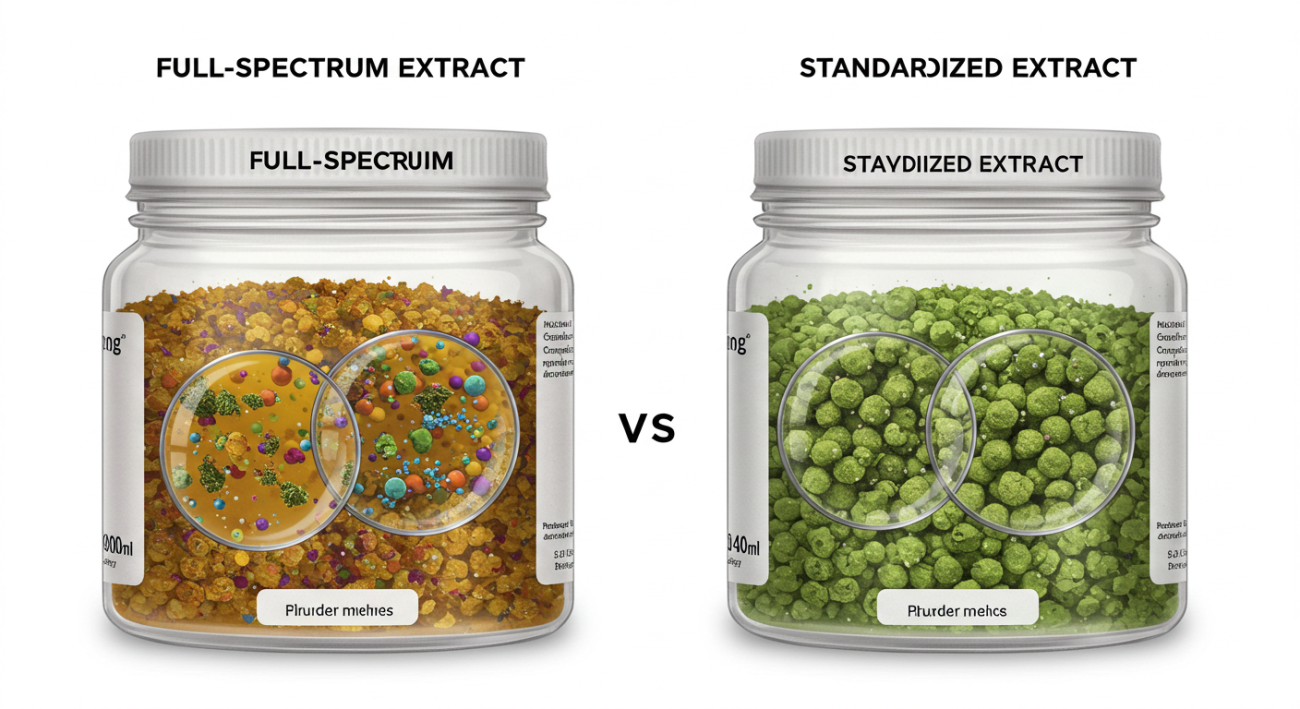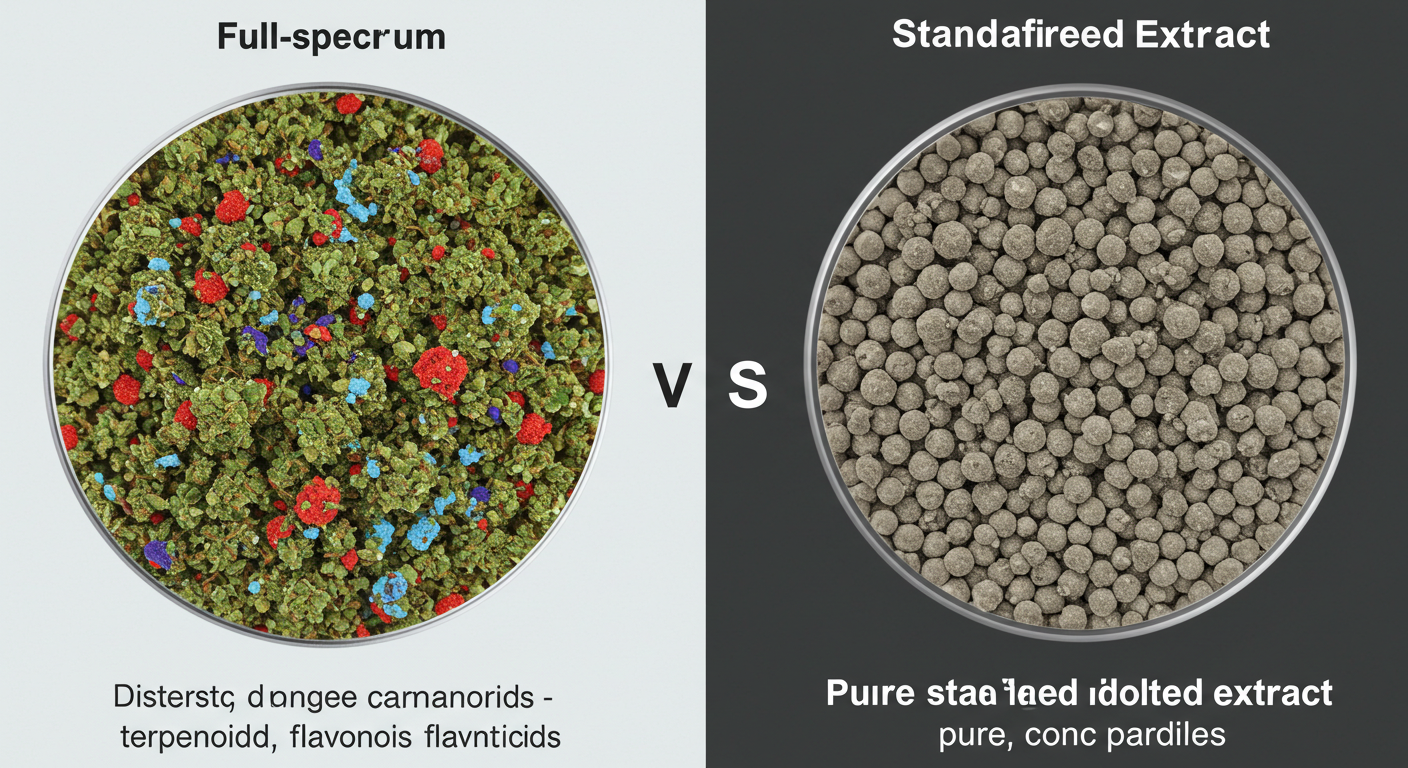A Guide
About dietary supplements, herbal extracts are particularly important to understand. For health and wellness-oriented individuals, the first question that emerges is, what is the difference between full-spectrum and standardized extracts? This article aims to address both forms and their differences, advantages, and practical applications to help you make your health decisions.
What are Herbal Extracts?
Herbal extracts are the result of phytochemicals derived from herbs by extraction processes, which are further purified by concentrating the active ingredients of a plant. Their application extends to nutraceuticals, cosmetics, and pharmaceuticals. The extraction process differs, and whether the extract is full-spectrum or standardized affects the potency, consistency, and overall effectiveness.
Full-Spectrum Extracts: An Overview
Definition
Full-spectrum extracts are derived from one or several portions of a plant, which is taken together with its bioactive constituents, along with proportionate ratios of its components. These extracts seek to capture a wide range of phytochemical profiles that are available in nature. This is the full spectrum approach to extract nature’s synergy.
Key Features
• All-inclusive profile containing primary metabolites as well as all the phytoconstituents, including, but not limited to, alkaloids, flavonoids, terpenes, and glycosides.
• Preserves the original structure of the herb
• Utilized in Ayurveda and Traditional Chinese Medicine Practices
• Helps to balance biological systems
Technical Note:
Standardized Processing: Full-spectrum extracts produced by hydroalcoholic or CO₂ extraction methods are able to protect sensitive components that might be damaged during processing.
Benefits
• Provides synergism from multiple constituents unlikely with single extracts.
• Gentle on the body
• Promotes long-term wellness.
• Supports ancient traditions of herbal medicine.
What are Standardized Extracts?
A standard herbal extract is defined as a composite herbal preparation intended to contain a specific quantity of one or more of its active constituents. As the name suggests, these extracts perform best where consistency, dependability, and precise results are needed. They ensure a constant potency and therapeutic effect for each batch, which is advantageous in clinics and pharmacies. Important Attributes.
• Guarantees active ingredients in specific amounts (Example: 95% curcumin, 40% silymarin)
• Complies with Good Manufacturing Practices (GMP)
• Frequently conducts clinical trials.
• Streamlined processes for developing dietary supplements
To comply with the law related to drugs, standardized extracts are highly consistent in strength and effectiveness across multiple batches. This allows for the scientific evidence supporting relevant functions to be confirmed and aids in targeted precision medicine, especially for acute health issues.

Why Choose the Standardized Extracts?
As per strict guided third-party laboratory protocols, extracts are tested for purity and potency and subjected to stability testing over time. Extracts follow biosecurity controls from plant procurement to packaging, providing control at each step for every labeled process. B-Thriving guarantees compliance with international regulatory frameworks on clinical safety and natural efficacy while assuring systemic effectiveness.
- Standardized and full-spectrum extracts are the most popular herbal dietary supplements, thus triggering attention from consumers and experts. In this article, we aim to explain the meaning of these two types of extracts and their distinguishing characteristics.
- Every aspect of a plant is utilized in full-spectrum herbal extracts. The co-factors and other active compounds are retained in the extracts. This is how nature intended it: the integration of all components. Full spectrum extracts are used widely in traditional herbal medicine due to their holistic therapeutic effects and help in restoring the body’s natural balance through nature.
Standardized extracts, on the other hand, are more precise and refined. These extracts tend to focus on isolating certain active compounds for greater concentration so that each dose will be potent and effective. There are controlled processes of manufacturing these extracts, which are awarded GMP, ISO, or other certifications, which ensure consistency in quality. For these reasons, standardized extracts are best for clinical research, precise formulation and dosing, or patients with specific outcomes.
Which One Should You Choose?
Consider how you intend to use your health supplements, then decide between the two types of extracts.
Full-Spectrum Extracts Are Best If You Want:
• A complete, holistic approach that utilizes all the active constituents of the plant.
• Milder effects that support long-term health.
• A supplement for general health maintenance that can be taken every day.
These are best for those who believe in nature’s restorative power, which allows the full spectrum extracts to work synergistically with the body over time.
Choose Standardized Extracts if You Need:
• Aid through a sharp and focused approach on a specific health concern.
• Immediate feedback or result.
• Each dose has proven clinical potency and consistent reliability.
Standardized herbal extracts excel for acute conditions needing precision and strength. These are often therapeutically prescribed by practitioners.
Regardless of what type you select, focus on the extract quality and source transparency.
The Health Benefits of Full-spectrum and Standardized Herb Extracts
Concerning your wellness objectives, both full-spectrum and standardized extract herbs offer unique benefits. Full-spectrum extracts are formulated to assist in resisting infections, relieving stress, and gradually improving digestion. These extracts have a mild mixture of active ingredients that help with daily wellness.
On the other hand, standardized extracts offer quicker, targeted results with scientific backup. With standardized formulas, these extracts are known to relieve inflammation swiftly, which is beneficial for acute conditions. Also, standardized extracts are used for hormonal balance and cognitive enhancement due to their measurable, concentrated compounds commonly observed during hormonal shifts in women.
Maximizing the benefits—whether immediate or long-term—of an herbal supplement requires choosing the correct form of extract.
What Tips Will Assist with My Choices?
Deciding between full-spectrum and standardized extracts begins with taking an assessment of your health goals. Do you wish to improve sleep? Immunity? Stress management? After attaining some clarity, decide whether you prefer gentle, holistic effects or swift, clinically precise outcomes. While full-spectrum extracts provide blended constituents intended to synergistically support the body over time, balanced full-spectrum extracts contain active ingredients for immediate targeted action.
Formulate a prioritized roadmap that best aligns with your advancing health objectives. Herbal supplements manufactured under the compliant Good Manufacturing Practices (GMP) should be sought for safety, and third-party lab reports for claim of purity and potency verification must be checked. These objectives can be attained without undermining quality. Above everything else, safety should come first. Always start with lower doses, observe, and then adjust.
Conclusion
What is the difference between full-spectrum and standardized extracts? Each serves its purpose relative to one’s wellness requirements. Full spectrum provides balance through nature, and standardized extracts provide uniform, measurable outcomes. There are no universal cures, but with accurate guidance, dependable information, trusted products, and suitable assistance, holistic alternatives are available for everybody. Looking for scientifically validated premium-grade herbal remedies? Visit B-Thriving and explore our vast collection today.

